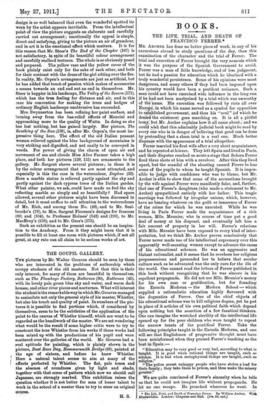ART.
THE NEW ENGLISH ART CLUB.
THE collection of pictures which the New English Art Club is now showing at the galleries of the Society of British Artists in Suffolk Street is a notable one. The hanging is good, the pictures are not crowded, and they are so arranged that they support rather than interfere with each other, and the average quality of the work is distinctly high. In one instance, at least, we feel ourselves in the presence of a re- markably fine picture, original and powerful, and full of that restraint which only a master's band knows. All Mr. Orpen's power of drawing and modelling, and his grasp of the essential character of the things he paints, are revealed in Myself and Cupid (164), and, added to them, fine colour and that rarest of qualities, a beautiful handling of oil paint. The artist is seen at half length standing reside a cast of Verrocchio's winged child carrying a dolphin. The picture is rich in colour, and the white of the cast and the gold frame of the mirror which reflects the artist shine out of the surround- ing darkness, while the materials of the painter's art which are scattered before the looking-glass add just the coloUr ana sparkle that are wanted to make the important parts of the picture retire into the depths of the shadow. Perhapi there is no greater test of the success of a picture than the fact that it convinces us at once of the reasonableness of all its details. In the present instariei3 the iiringeinent is highly artAcial, lal)t we are not troubled by that, for thil.
design is so well balanced that even the wonderful spotted tie worn by the artist appears inevitable. From the intellectual point of view the picture suggests an elaborate and carefully carried out arrangement ; emotionally the appeal is simple, direct and satisfying, giving to the picture an air of grandeur, and in art it is the emotional effect which matters. It is for this reason that Mr. Steer's The End of the Chapter (167) is not satisfactory, in spite of its beautiful colour arrangement and carefully realized textures. The whole is so obviously posed and prepared. The yellow vase and the yellow cover of the book plainly exist only for the sake of each other, and both for their contrast with the dress of the girl sitting over the fire. In reality, Mr. Orpen's arrangements are just as artificial, but he has added that touch of passion which makes of accessories a means towards an end and not an end in themselves. Mr. Steer is happier in his landscape, The Valley of the Severn (171), which has the true feeling for distance and air, and in this ease his convention for making the trees and hedges of ordinary English landscape unobtrusive has succeeded.
Mrs. Swynnerton has been refining her paint surface, and turning away from the bas-relief effects of Mancini and approaching more to the quality of Watts. In doing so she has lost nothing, but has gained largely. Her picture, The Southing of the Sun (139), is, after Mr. Orpen's, the most im- pressive thing here. The effect of the old Italian peasant woman relieved against the blue background of mountains is very striking and dignified, and not easily to be conveyed in words. For power of giving the charm of open air and movement of sea and clouds Miss Alice Farmer takes a high place, and both her pictures (138, 155) are ornaments to the gallery. Mr. Sargent shows several pictures ; in these it is by the colour arrangement that we are most attracted, and especially is this the case in the watercolour, Daphne (32). Here a marble statue is relieved partly against the sky and partly against the dark cypress trees of the Italian garden. What other painter, we ask, could have made us feel the sky reflecting marble so simply and so beautifully ? Had space allowed, several other pictures might have been discussed in detail, but it must suffice to call attention to the watercolours of Mr. Rich, and among them No. (40), and to Mr. Seal- brooke's (76), to Mrs. Sargent Florence's designs for frescoes (89) and (104), to Professor Holmes' (143) and (190), to Mr. MacEvoy's (158), and to Mr. Gere's (175).
Such an exhibition as the present one should be an inspira- tion to the Academy. From it they might learn that it is possible to fill at least one room with pictures which, if not all great, at any rate can all claim to be serious works of art.











































 Previous page
Previous page